In the vast wilderness of North America and Eurasia, a remarkable natural spectacle unfolds each autumn. As daylight hours wane and temperatures drop, the largest members of the deer family, the moose (Alces alces), engage in an intricate and intense mating season. This annual period, known as the rut, transforms ordinarily solitary bulls into aggressive competitors vying for the attention of receptive cows. The elaborate courtship behaviors, physical confrontations, and vocal displays represent some of the most dramatic mating rituals in the animal kingdom. From their impressive antler growth to their haunting calls that echo through forests, bull moose employ various strategies to assert dominance and earn breeding rights. This fascinating reproductive process showcases the remarkable adaptations these magnificent animals have developed through evolutionary time.
The Timing of the Rut: Nature’s Perfect Calendar

The moose mating season, or rut, follows a predictable annual schedule primarily dictated by photoperiod—the length of daylight hours. In most regions across their range, the rut begins in early September and extends through October, with peak activity typically occurring in late September. This timing is no coincidence; it ensures calves will be born in late May or early June when spring vegetation provides abundant nutrition for nursing mothers. Female moose come into estrus for only 24-48 hours during this period, creating intense competition among males who must be in peak condition and ready to compete when the brief opportunity arises. Interestingly, the rut’s timing can vary slightly by latitude, with northern populations beginning slightly earlier than southern populations due to differences in seasonal progression.
Antler Development: Growing Natural Weapons
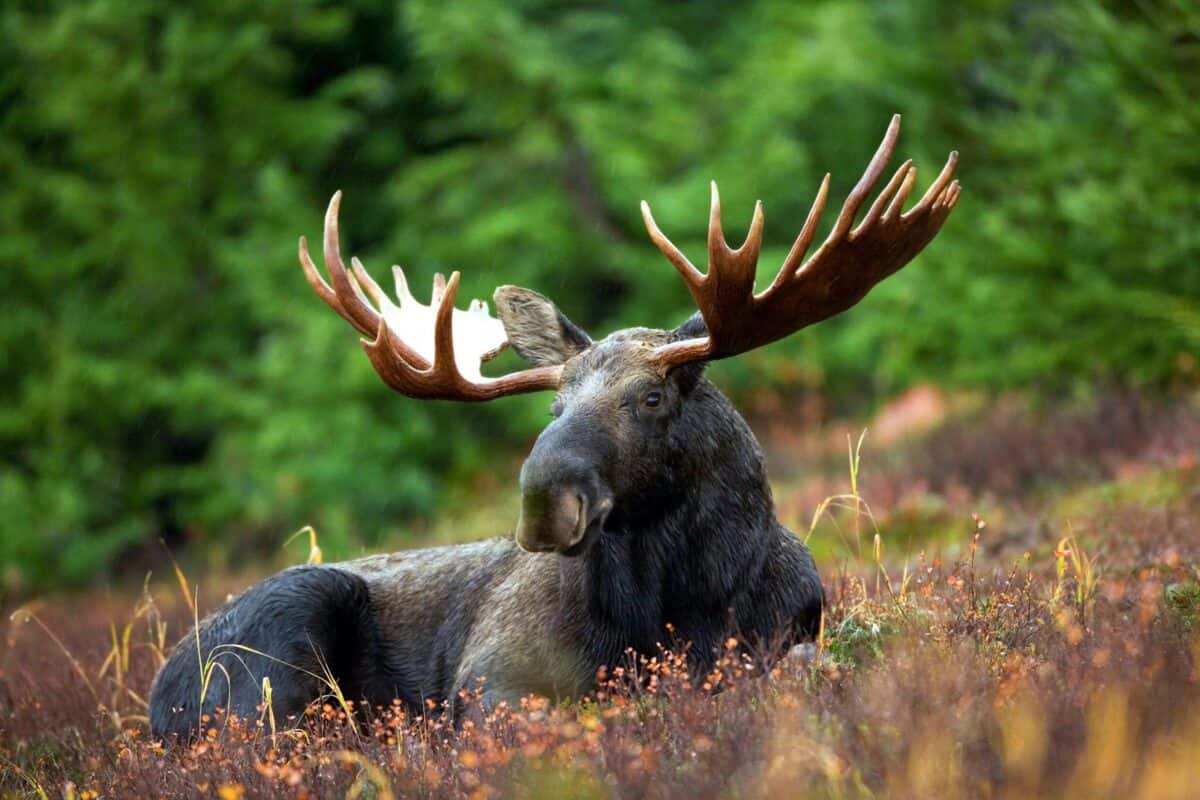
Perhaps the most visible preparation for the rut begins months earlier when bull moose start growing their impressive antlers. This process typically begins in April, after the previous year’s antlers have been shed. Antler growth represents one of the fastest tissue development processes in the animal kingdom, with bulls growing up to one pound of bone material per day during peak development. By August, a mature bull may carry antlers spanning up to six feet across and weighing up to 40 pounds. These massive structures aren’t merely for show—they serve as weapons in combat and visual signals of a bull’s age, health, and genetic quality. The antler development cycle is closely tied to testosterone levels, which begin rising in summer and peak during the rut. Remarkably, these enormous structures grow completely new each year, coated in a velvet-like tissue that provides blood supply during growth before being shed as the antlers harden for the mating season.
Physical Transformation: The Rut Makeover
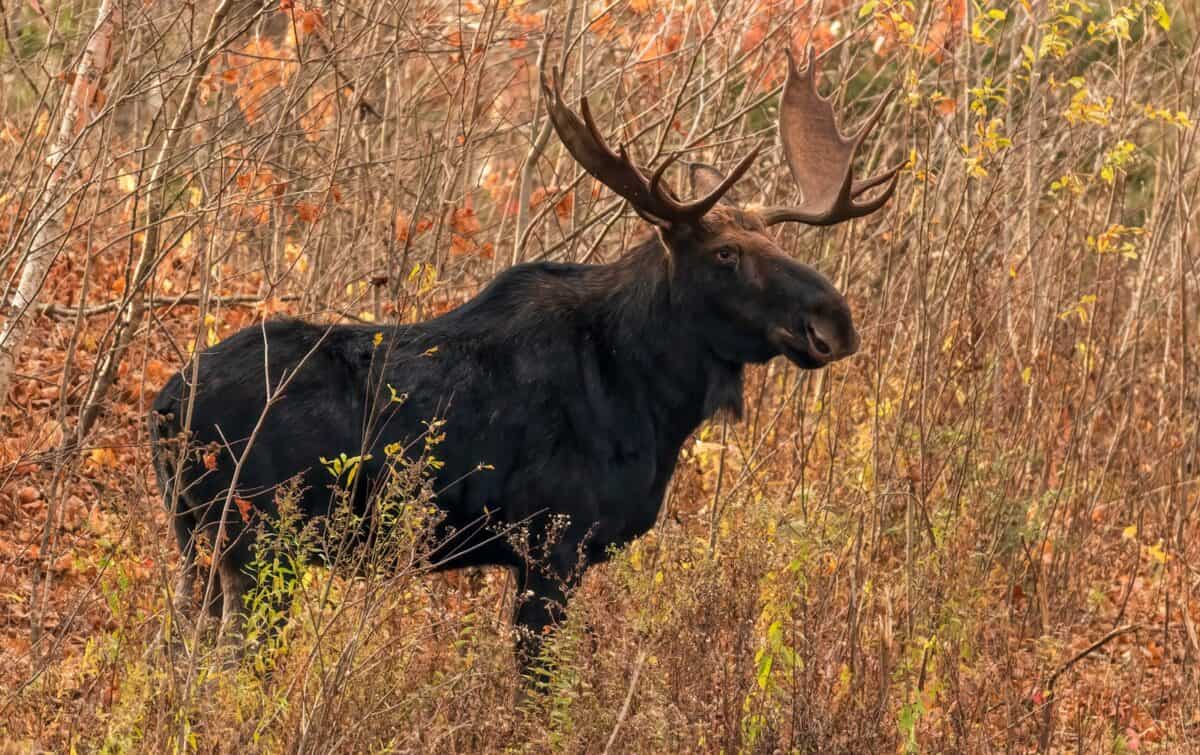
Bull moose undergo dramatic physical changes as the rut approaches. Beyond antler development, bulls experience substantial alterations to their appearance and physiology. Their necks swell significantly due to increased muscle mass and fluid retention, preparing them for the physical demands of combat. Their coats darken, and they develop a distinctive “bell”—a dangling flap of skin under the throat that becomes more pronounced during this period. Most notably, bulls stop eating almost entirely during the peak rut, losing up to 20% of their body weight while focusing exclusively on finding mates. Their muzzles and facial features often appear swollen, and glands near their eyes enlarge, secreting chemicals that communicate their reproductive status. Even their posture changes, as they begin walking with a distinctive swagger, holding their heads high to display their antlers prominently. These transformations collectively signal to females and rival males that the bull is in prime breeding condition.
The Rutting Pit: Creating Territorial Markers
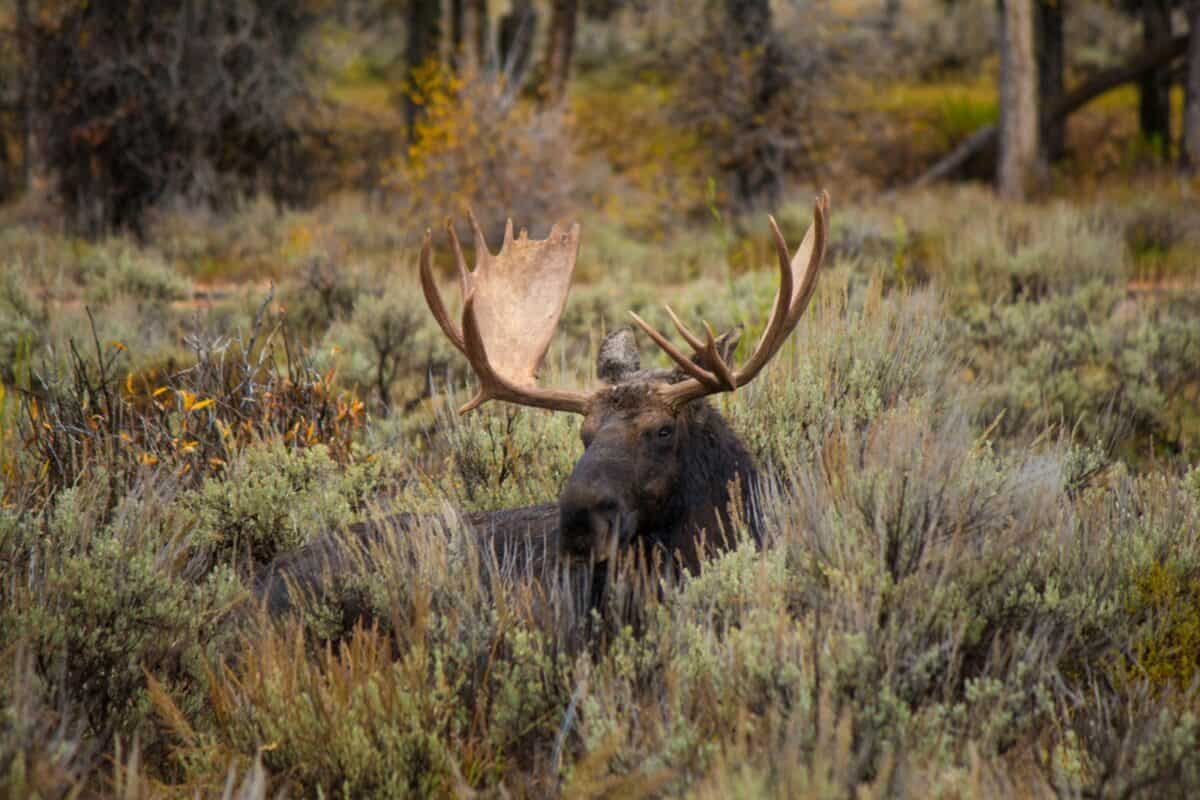
One of the most peculiar behaviors bull moose exhibit during the rut is the creation and maintenance of “rutting pits” or “wallows.” These are shallow depressions in soft ground that the bull digs using his hooves and antlers. After creating this pit, the bull urinates in it and then splashes the urine-soaked mud onto his neck and antlers before rolling in the mixture. While seemingly unsanitary to human observers, this behavior serves crucial communication purposes. The urine contains pheromones and hormonal information that advertises the bull’s reproductive status and dominance. The strong musky odor from these wallows can attract cows from considerable distances and warn off less dominant males. Bulls will return to their rutting pits repeatedly throughout the season, refreshing the scent markers and monitoring for the presence of rival males or potential mates who may investigate the site. These olfactory signposts effectively extend a bull’s physical presence throughout his territory.
The Iconic Call: Vocalizing for Attention

Perhaps the most haunting and recognizable aspect of moose mating rituals is the bull’s distinctive vocalization known as “grunting” or “croaking.” These low-frequency calls can travel more than a mile through forest habitat and serve multiple purposes in the mating ritual. The calls advertise a bull’s presence to potential mates, challenge rival males, and help individuals locate each other in dense vegetation. A typical call consists of a series of deep grunts lasting several seconds, often repeated in sequences that can continue for hours, particularly at dawn and dusk. The acoustic properties of these calls communicate valuable information about the bull’s size and condition, with larger bulls typically producing deeper, more resonant vocalizations that signal their dominance. Cows respond to these calls when receptive, sometimes approaching the source or replying with their own softer calls that guide the bull to their location. The frequency and intensity of calling increase dramatically when a bull detects a cow in estrus nearby.
Antler Displays: Visual Intimidation Tactics

When bull moose encounter each other during the rut, they engage in elaborate visual displays centered around their impressive antlers. These displays often begin with what biologists call “parallel walking,” where two bulls walk side by side, each attempting to intimidate the other with his size and antler spread. During these encounters, bulls hold their heads high and turn sideways to maximize the apparent size of their rack. They may swing their antlers from side to side, thrashing nearby vegetation in displays of strength and aggression. Another common demonstration involves rubbing or “polishing” antlers against trees, stripping bark and breaking branches—actions that not only clean the antlers of remaining velvet but also demonstrate the bull’s power to any watching rivals. These displays serve an important evolutionary function by allowing males to assess each other’s fighting ability without immediately resorting to potentially injurious physical combat. In many cases, these preliminary demonstrations alone determine dominance, with the smaller bull retreating without escalation to actual combat.
Battle for Dominance: When Displays Escalate to Combat

When visual displays and posturing fail to establish clear dominance, bull moose engage in one of nature’s most impressive combat rituals. These confrontations begin with bulls lowering their antlers and charging at each other, resulting in a dramatic clash as their massive racks collide. The impact can be heard from considerable distances through the forest. After initial contact, the bulls engage in a pushing contest, each attempting to force the other backward while their antlers remain locked together. This test of strength can last from several minutes to over an hour, with bulls circling, pushing, and twisting to gain advantage. Though rarely resulting in death, these battles can cause serious injuries including puncture wounds, broken antler tines, and occasionally, fatally entangled antlers that neither bull can escape. The winner typically maintains breeding rights in a territory, though challenges may continue throughout the rutting season. Research suggests that successful bulls win through a combination of physical strength, antler size and configuration, fighting technique, and sheer determination.
Scent Communication: The Chemical Conversation
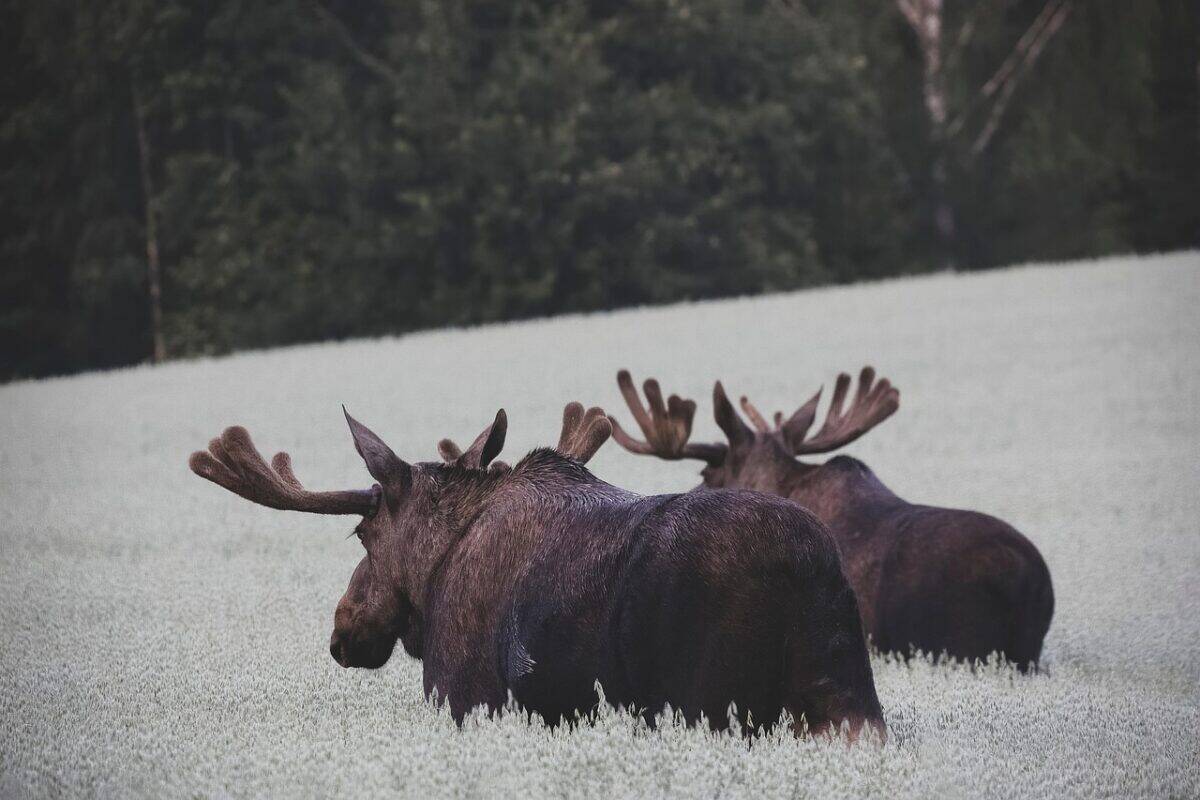
While visual and acoustic signals play important roles in moose mating rituals, chemical communication through scent may be the most sophisticated aspect of their reproductive behavior. Bull moose possess specialized forehead glands that become particularly active during the rut, secreting oily substances containing information about the individual’s identity, condition, and dominance status. Bulls frequently rub these glands against trees and shrubs, creating scent posts throughout their territory. Additionally, their urine contains high concentrations of pheromones during this period, which they spread through splashing behaviors and the creation of rutting pits. Female moose also communicate through scent, releasing specific pheromones when approaching estrus that can trigger intense response behaviors in bulls. These chemical signals provide remarkably detailed information that helps coordinate the precise timing required for successful breeding. The moose’s exceptional sense of smell allows them to detect these chemical messages from great distances and interpret nuanced information about potential mates that visual or acoustic signals alone cannot convey.
Female Choice: How Cows Select Their Mates

While bull moose competition receives the most attention, female moose exercise considerable influence in the mating process through selective behaviors. Cows typically demonstrate preference for older, more dominant bulls with larger antlers, which likely indicates better genetic quality. However, their selection criteria extend beyond physical attributes. Females often observe male competitions from a distance, assessing fighting ability and persistence. Interestingly, cows frequently engage in “testing” behaviors, including running away from pursuing bulls, requiring them to demonstrate stamina and determination. A cow may also approach multiple bulls before allowing mating, sometimes provoking competition between males to ensure she pairs with the most dominant individual. Research indicates that female choice favors bulls in their prime (5-10 years old) rather than younger or very old individuals. This selection process represents an important evolutionary mechanism ensuring offspring receive genetic advantages. Despite the aggressive nature of male competition, cows maintain significant control over mating outcomes through their selective receptivity during their brief estrus period.
The Mating Process: A Brief but Critical Encounter

When a bull moose successfully attracts a receptive cow, the actual mating process is surprisingly brief compared to the elaborate courtship behaviors that precede it. The bull will closely guard the cow during her 24-48 hour estrus period, maintaining proximity and warding off any rival males that approach. As the female becomes fully receptive, she adopts a distinctive stance with her head lowered and tail raised slightly. The mating itself typically lasts less than a minute, though it may be repeated several times during the cow’s receptive period. After successful copulation, the bull may continue to guard the female for a short time, but this partnership is temporary. Once the cow’s estrus ends, the pair separates, and the bull resumes searching for other receptive females. This brief reproductive encounter belies its biological significance—the fertilized egg won’t implant immediately but enters a delayed development phase, allowing the pregnancy to progress with optimal timing for spring birthing. For successful bulls, this reproductive strategy can result in multiple offspring with different females during a single mating season.
Post-Rut Recovery: The Aftermath of Breeding Season
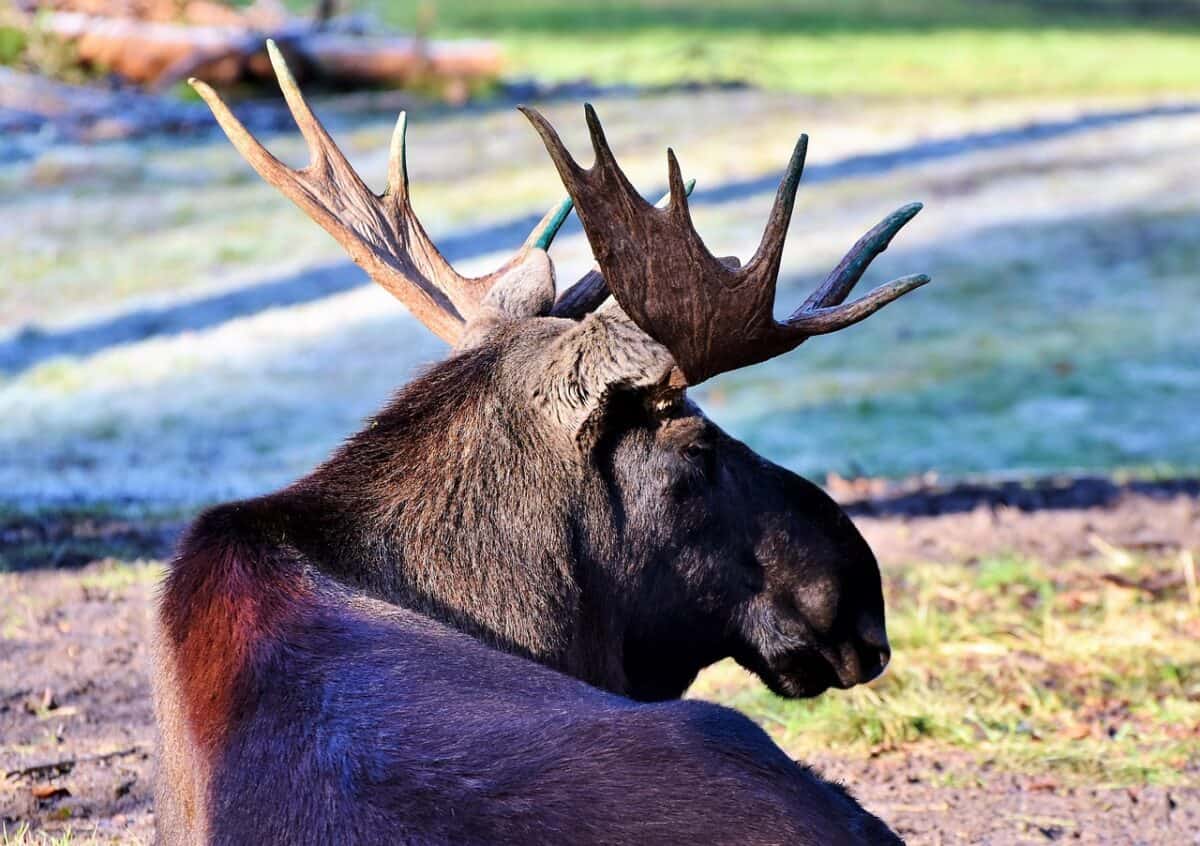
The conclusion of the rut marks the beginning of a critical recovery period for bull moose. Having expended enormous energy reserves through reduced feeding, physical combat, and constant movement, bulls emerge from the breeding season significantly depleted. Bulls may have lost 15-20% of their pre-rut body weight, placing them in a precarious position as winter approaches. Their first priority becomes intensive feeding to rebuild fat reserves before deep snow and cold temperatures limit food availability. Testosterone levels drop rapidly, triggering physiological changes including reduced aggression and eventual antler shedding, which typically occurs by early winter. The timing of this recovery is critical—bulls must regain sufficient condition before winter’s full onset or risk not surviving until spring. Those that have sustained injuries during combat face additional challenges during this recovery phase. Remarkably, even after such physical depletion, healthy bulls can fully recover their condition, grow even larger antlers the following spring, and return to the competitive mating arena annually for up to a decade during their prime breeding years.
Evolutionary Significance: Why Such Elaborate Rituals?

The elaborate and energy-intensive mating rituals of moose represent a classic example of sexual selection—the evolutionary process where certain traits become more common because they enhance breeding success. The enormous antlers, aggressive behaviours, and physical transformations bull moose undergo have evolved because they help secure mating opportunities in a competitive environment. From an evolutionary perspective, the tremendous energy investment and even physical risk these rituals entail is balanced by the reproductive advantage successful bulls gain. Interestingly, these mating systems create a form of natural quality control—only the strongest, healthiest males with the best genes typically reproduce, theoretically strengthening the species’ overall fitness. The annual regrowth of antlers ensures that males must repeatedly prove their genetic quality and physical condition rather than relying on past success. This continuous testing helps maintain genetic diversity and adaptability within moose populations. Scientists studying these behaviours gain valuable insights into evolutionary processes, as moose mating rituals represent one of nature’s most dramatic examples of how reproduction shapes physical traits and behaviours over evolutionary time.
The mating rituals of moose represent one of the animal kingdom’s most dramatic reproductive spectacles, blending physical prowess, complex communication, and evolutionary adaptation into an annual display of natural selection in action. Through their impressive antler growth, fierce competitions, and sophisticated scent communication, bull moose demonstrate the extraordinary lengths to which species will go to ensure genetic continuation. While appearing chaotic and violent to casual observers, these behaviors follow sophisticated biological patterns that have evolved over thousands of years to optimize reproductive success in challenging northern environments. For wildlife enthusiasts, these autumn rituals offer rare glimpses into the private lives of these normally solitary animals, revealing complex social behaviors typically hidden from human observation. As climate change and habitat disruption increasingly affect northern ecosystems, understanding these reproductive behaviors becomes increasingly important for conservation efforts aimed at ensuring these magnificent creatures continue their ancient mating traditions for generations to come.
- America’s Most Endangered Mammals And How to Help - August 9, 2025
- The Coldest Town in America—And How People Survive There - August 9, 2025
- How Some Birds “Steal” Parenting Duties From Others - August 9, 2025

